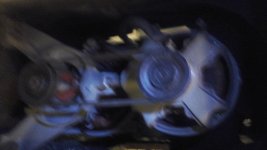Hello everybody,
I recently acquired a 10EE (mfg date 8/44, S/N 25871), and I would really like to get a full understanding of the control system of this remarkable machine.
To get to the point, I'm looking for the complete shematic shown partially in this previous post. https://www.practicalmachinist.com/...99h15c-343780/?highlight=1955+10EE+Schematic?
It seems to best match the control system I have. Apparently from my research, late 44' was the transition period for control systems on EE's
(Interesting Footnote)If the previous owner's info is reliable, this lathe was originally bought by the gov't.new in 44' and sent to Los Alamos Lab and stayed there until he bought it a couple years ago. (plausible because his shop is in Albequerque) I don't care either way, it beats the hell out of the
11x20 Logan it's replacing, even though it was a great little lathe in it's own right too.
My machine Has a Reliance MG and Motor, The MG and exciter look fairly recently reworked,cleaned,Glyptoled,and painted (they shine like a diamond in a goat's ass compared to everything else) All of the comm's are clean,reasonably bright, and smoothe. The only blemish I find is a couple of wide/burnt out spaces between a couple of the MG comm segments,but they look to be old damage prior to refurb,turning, or whatever caused the MG to be repainted.
Upon powering it up, everything seemed to work fine no sparking at any of the brushes at all.Only problem was that the spindle motor would not speed up past about 800rpm, and the spindleFWD/Reveerse switch operates backwards(left= reverse,right+ foreward) Max voltages at E1-E2 133,F2-E2 136, A1-A2 280. The FA relay was hanging in. If I forced open the FA relay with a wooden dowel while turning the pots on up past half way, the motor would speed up like it should. Checked all of the resisters as was suggested in another thread, all checked out ok.
After combing all the posts I could find on the condition, I tried adjusting the spring tension up on the FA relay, which seems to have solved the issue. Now the motor and spindle comes up to speed quickly and the FA relay pulls in on start , then drops out about 1/2-2/3 of the way up to speed. (on occasion it will peck in and out a time or two on the way up from dead start to 1750rpm (spindle speed) with an 8" chuck on, but drops out before set speed is reached as I believe it should.
Even though my machine is a Round Dial, it has what appears to be the early 1950's generation of MG controls. the DC control box is a Cutler Hammer #C292885A31 115/230 volt 12.3 Amp DC control.
Sorry for the crappy pics,best I could manage right now.
I recently acquired a 10EE (mfg date 8/44, S/N 25871), and I would really like to get a full understanding of the control system of this remarkable machine.
To get to the point, I'm looking for the complete shematic shown partially in this previous post. https://www.practicalmachinist.com/...99h15c-343780/?highlight=1955+10EE+Schematic?
It seems to best match the control system I have. Apparently from my research, late 44' was the transition period for control systems on EE's
(Interesting Footnote)If the previous owner's info is reliable, this lathe was originally bought by the gov't.new in 44' and sent to Los Alamos Lab and stayed there until he bought it a couple years ago. (plausible because his shop is in Albequerque) I don't care either way, it beats the hell out of the
11x20 Logan it's replacing, even though it was a great little lathe in it's own right too.
My machine Has a Reliance MG and Motor, The MG and exciter look fairly recently reworked,cleaned,Glyptoled,and painted (they shine like a diamond in a goat's ass compared to everything else) All of the comm's are clean,reasonably bright, and smoothe. The only blemish I find is a couple of wide/burnt out spaces between a couple of the MG comm segments,but they look to be old damage prior to refurb,turning, or whatever caused the MG to be repainted.
Upon powering it up, everything seemed to work fine no sparking at any of the brushes at all.Only problem was that the spindle motor would not speed up past about 800rpm, and the spindleFWD/Reveerse switch operates backwards(left= reverse,right+ foreward) Max voltages at E1-E2 133,F2-E2 136, A1-A2 280. The FA relay was hanging in. If I forced open the FA relay with a wooden dowel while turning the pots on up past half way, the motor would speed up like it should. Checked all of the resisters as was suggested in another thread, all checked out ok.
After combing all the posts I could find on the condition, I tried adjusting the spring tension up on the FA relay, which seems to have solved the issue. Now the motor and spindle comes up to speed quickly and the FA relay pulls in on start , then drops out about 1/2-2/3 of the way up to speed. (on occasion it will peck in and out a time or two on the way up from dead start to 1750rpm (spindle speed) with an 8" chuck on, but drops out before set speed is reached as I believe it should.
Even though my machine is a Round Dial, it has what appears to be the early 1950's generation of MG controls. the DC control box is a Cutler Hammer #C292885A31 115/230 volt 12.3 Amp DC control.
Sorry for the crappy pics,best I could manage right now.








